By David Pan · Friday, April 5, 2024 Telos 206 (Spring 2024): The Intuitive and the Conceptual is now available for purchase in our store. Individual subscriptions to Telos are also available in both print and online formats.
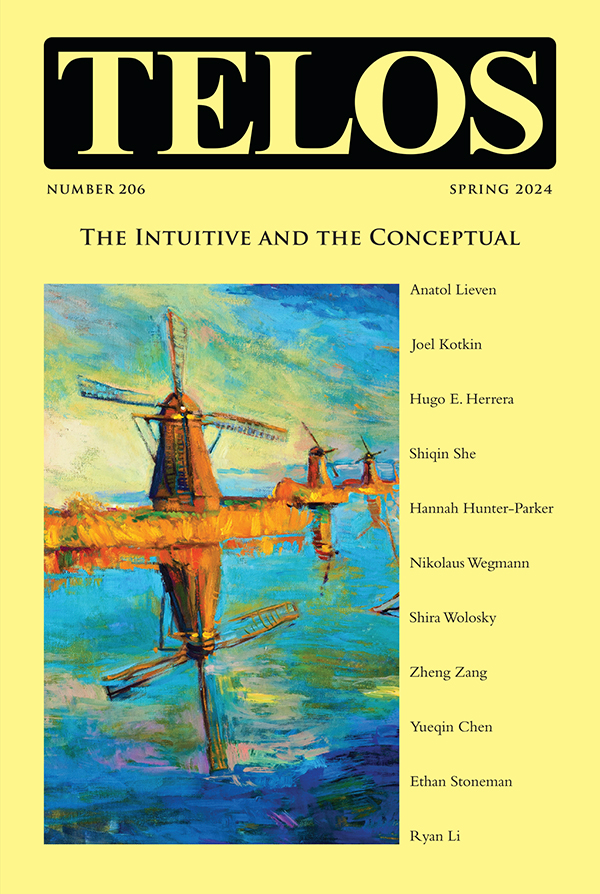 We often have the experience of intuiting something without being able to precisely define what that intuition is. Sometimes this intuition leads to a more well-defined insight, and sometimes it might lead to some kind of action, even in the absence of clear conceptual definitions. Yet it is difficult to ascertain what kind of knowledge or awareness such intuitions consist of. What is an intuition as opposed to a defined concept of something? How seriously should we take such intuitions? Are they something separate and qualitatively different than concepts? Are they just fuzzy concepts? Do they really exist at all? These are crucial questions because they lead to conclusions about the status of concepts themselves. If the alternative to clear concepts is nothing at all, then the sociopolitical corollary would be that the alternative to conceptual knowledge and the holders of such knowledge would also be nothing at all. By contrast, if intuitions are separate from concepts and real, then expert knowledge might possibly have some deficiencies in comparison with intuitions. The essays in this issue of Telos explore in one way or another this question of the status of conceptual knowledge as opposed to intuitive awareness. We often have the experience of intuiting something without being able to precisely define what that intuition is. Sometimes this intuition leads to a more well-defined insight, and sometimes it might lead to some kind of action, even in the absence of clear conceptual definitions. Yet it is difficult to ascertain what kind of knowledge or awareness such intuitions consist of. What is an intuition as opposed to a defined concept of something? How seriously should we take such intuitions? Are they something separate and qualitatively different than concepts? Are they just fuzzy concepts? Do they really exist at all? These are crucial questions because they lead to conclusions about the status of concepts themselves. If the alternative to clear concepts is nothing at all, then the sociopolitical corollary would be that the alternative to conceptual knowledge and the holders of such knowledge would also be nothing at all. By contrast, if intuitions are separate from concepts and real, then expert knowledge might possibly have some deficiencies in comparison with intuitions. The essays in this issue of Telos explore in one way or another this question of the status of conceptual knowledge as opposed to intuitive awareness.
Continue reading →
By J. F. Dorahy · Tuesday, May 14, 2013 As an occasional feature on TELOSscope, we highlight a past Telos article whose critical insights continue to illuminate our thinking and challenge our assumptions. Today, J. F. Dorahy looks at Seyla Benhabib’s “Modernity and the Aporias of Critical Theory,” from Telos 49 (Fall 1981).
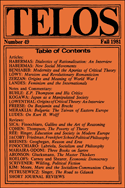 The critical theory of the Frankfurt School begins with Max Weber. With this claim I do not mean to suggest that Weber was the first critical theorist—as is well known, Hegel, Marx, and Nietzsche, each of whom wrote before Weber and had enormous influence on the Frankfurt School, are, to a greater or lesser extent, critical theorists. Rather, what this assertion draws attention to is the perspectival significance that Weber’s analysis of modernity holds for not only the first generation of the Frankfurt School—Adorno, Horkheimer, and Marcuse—but also for Habermas. In the last few decades, particularly in the highly influential and groundbreaking work of Axel Honneth, the Weberian diagnosis of modernity has lost its orientating position for critical theory. In its place stands the Hegelian notion of intersubjective recognition; subsequently, the once decisive notions of “rationalization” and “disenchantment” have given way, in contemporary critical theory, to the notions of “paradoxical development” and “disrespect.” Certainly, the socio-historical developments of the late twentieth and early twenty-first centuries bring into question the project and function of critical theory. So, too, the reflexive nature of the discourse necessitates the re-evaluation of its guiding concepts. Yet, many theorists have expressed significant reservations about the trajectory of contemporary critical theory, a trajectory that, in the words of Nikolas Kompridis, has veered “from reason to self-realization.” Perhaps, then, given the contemporary debate regarding the future directions of critical theory, the time is appropriate to revisit the history of critical theory and examine its variegated responses to the irrationality of modern reason. The critical theory of the Frankfurt School begins with Max Weber. With this claim I do not mean to suggest that Weber was the first critical theorist—as is well known, Hegel, Marx, and Nietzsche, each of whom wrote before Weber and had enormous influence on the Frankfurt School, are, to a greater or lesser extent, critical theorists. Rather, what this assertion draws attention to is the perspectival significance that Weber’s analysis of modernity holds for not only the first generation of the Frankfurt School—Adorno, Horkheimer, and Marcuse—but also for Habermas. In the last few decades, particularly in the highly influential and groundbreaking work of Axel Honneth, the Weberian diagnosis of modernity has lost its orientating position for critical theory. In its place stands the Hegelian notion of intersubjective recognition; subsequently, the once decisive notions of “rationalization” and “disenchantment” have given way, in contemporary critical theory, to the notions of “paradoxical development” and “disrespect.” Certainly, the socio-historical developments of the late twentieth and early twenty-first centuries bring into question the project and function of critical theory. So, too, the reflexive nature of the discourse necessitates the re-evaluation of its guiding concepts. Yet, many theorists have expressed significant reservations about the trajectory of contemporary critical theory, a trajectory that, in the words of Nikolas Kompridis, has veered “from reason to self-realization.” Perhaps, then, given the contemporary debate regarding the future directions of critical theory, the time is appropriate to revisit the history of critical theory and examine its variegated responses to the irrationality of modern reason.
Continue reading →
By J. F. Dorahy · Tuesday, April 16, 2013 As an occasional feature on TELOSscope, we highlight a past Telos article whose critical insights continue to illuminate our thinking and challenge our assumptions. Today, J. F. Dorahy looks at Joel Whitebook’s “Saving the Subject: Modernity and the Problem of the Autonomous Individual,” from Telos 50 (Winter 1981).
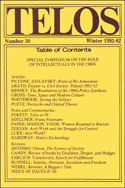 Autonomy is, arguably, the most fundamental concept in the discursive constellation of modernity. If it is apposite, and I believe it is, to think in terms of the differentiation between political, socio-economic, and cultural modernities, then it is clear that the concept of autonomy—either with reference to the autonomous individual or the autonomous work of art—is a constitutive force within each sphere. In “Saving the Subject: Modernity and the Problem of the Autonomous Individual,” Joel Whitebook offers a historically nuanced overview of the difficulties involved in thinking the “autonomous individual” under the conditions of a dynamic and increasingly complex modernity. Whitebook’s piece is wide-ranging and fuses a deep psychoanalytic insight with a robust sociological consciousness: a fusion that accompanies, to my mind, the best critical theory. To be sure, the many subtleties and divergences that emerge from Whitebook’s dialectic are resistant to a full reconstruction within this preview. Rather, I would like to simplify Whitebook’s account by drawing out the three historical epochs examined by Whitebook and say a few things regarding the key aspects of Whitebook’s reading of Marx and Freud and Adorno and Habermas as thinkers who most significantly appreciate the problematic nature of the modern, autonomous individual. Finally, I conclude by arguing for the innovative character of Whitebook’s thoughts regarding the centrality of affective relationships in the formation of the autonomous individual. Autonomy is, arguably, the most fundamental concept in the discursive constellation of modernity. If it is apposite, and I believe it is, to think in terms of the differentiation between political, socio-economic, and cultural modernities, then it is clear that the concept of autonomy—either with reference to the autonomous individual or the autonomous work of art—is a constitutive force within each sphere. In “Saving the Subject: Modernity and the Problem of the Autonomous Individual,” Joel Whitebook offers a historically nuanced overview of the difficulties involved in thinking the “autonomous individual” under the conditions of a dynamic and increasingly complex modernity. Whitebook’s piece is wide-ranging and fuses a deep psychoanalytic insight with a robust sociological consciousness: a fusion that accompanies, to my mind, the best critical theory. To be sure, the many subtleties and divergences that emerge from Whitebook’s dialectic are resistant to a full reconstruction within this preview. Rather, I would like to simplify Whitebook’s account by drawing out the three historical epochs examined by Whitebook and say a few things regarding the key aspects of Whitebook’s reading of Marx and Freud and Adorno and Habermas as thinkers who most significantly appreciate the problematic nature of the modern, autonomous individual. Finally, I conclude by arguing for the innovative character of Whitebook’s thoughts regarding the centrality of affective relationships in the formation of the autonomous individual.
Continue reading →
By Yonathan Listik · Tuesday, March 12, 2013
As an occasional feature on TELOSscope, we highlight a past Telos article whose critical insights continue to illuminate our thinking and challenge our assumptions. Today, Yonathan Listik looks at Jürgen Habermas’s “On Social Identity,” from Telos 19 (Spring 1974).
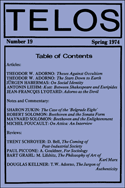 Jürgen Habermas’s objective in “On Social Identity” is clearly defending the usage of instrumental rationality toward the development of a universal morality. For Habermas, the new social identity should be constructed through universalistic moral systems, thereby eliminating possible frictions or incoherence present in modern society. The obsolescence of the state and its replacement by autonomous means of identity construction, such as art, already point to his emphasis on a more particular form of identity construction. Jürgen Habermas’s objective in “On Social Identity” is clearly defending the usage of instrumental rationality toward the development of a universal morality. For Habermas, the new social identity should be constructed through universalistic moral systems, thereby eliminating possible frictions or incoherence present in modern society. The obsolescence of the state and its replacement by autonomous means of identity construction, such as art, already point to his emphasis on a more particular form of identity construction.
Continue reading →
By Casey Servais · Thursday, July 12, 2012 Casey Servais’s “‘A Certain Light, But Only a Juridical Light’: The Legal Aesthetics of Thomas Bernhard’s The Lime Works” appears in Telos 159 (Summer 2012). Read the full version online at the Telos Online website, or purchase a print copy of the issue here.
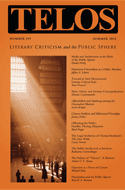 Taking Thomas Bernhard’s 1970 novel The Lime Works as an exemplar of a group of post-World War II German and Austrian literary works that mimic identifiable genres of legal writing, this article offers two alternative theoretical models for making sense of the prevalence of legal-literary genre-mixing in postwar German-language literature. Viewed through the lens of Theodor W. Adorno’s Aesthetic Theory, the literary imitation of legal styles appears as an instance of “mimesis of the lethal,” the process by which artworks both adapt to and resist what Adorno calls “reification.” Viewed through the alternative lens of Jürgen Habermas’s Theory of Communicative Action, the literary use of legal styles can be seen as a way of partially reconciling modernity’s specialized discourses (such as science, art, and law) by uncovering the “tortuous routes” along which these discourses communicate with one another. Through a mixture of theory and formal analysis, the article offers both a new reading of Bernhard’s work and a new set of theoretical approaches that may prove fruitful to the study of Taking Thomas Bernhard’s 1970 novel The Lime Works as an exemplar of a group of post-World War II German and Austrian literary works that mimic identifiable genres of legal writing, this article offers two alternative theoretical models for making sense of the prevalence of legal-literary genre-mixing in postwar German-language literature. Viewed through the lens of Theodor W. Adorno’s Aesthetic Theory, the literary imitation of legal styles appears as an instance of “mimesis of the lethal,” the process by which artworks both adapt to and resist what Adorno calls “reification.” Viewed through the alternative lens of Jürgen Habermas’s Theory of Communicative Action, the literary use of legal styles can be seen as a way of partially reconciling modernity’s specialized discourses (such as science, art, and law) by uncovering the “tortuous routes” along which these discourses communicate with one another. Through a mixture of theory and formal analysis, the article offers both a new reading of Bernhard’s work and a new set of theoretical approaches that may prove fruitful to the study of
Continue reading →
By David Randall · Wednesday, January 11, 2012 David Randall’s “Humean Aesthetics and the Rhetorical Public Sphere” appears in Telos 157 (Winter 2011). Read the full version online at the TELOS Online website, or purchase a print copy of the issue here.
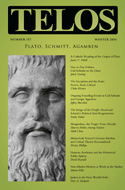 This article aims to locate in the writings of David Hume the rhetorical aesthetics and philosophy of judgment that, under the name of “the conversable world,” constituted, in its essentials, the discursive, political, and moral project of Jürgen Habermas’s public sphere. Here the idea of the public sphere was shorn of the Kantian imperative to reason. Instead, Hume’s “conversable world” registered rhetorical assumptions—the key words reflecting the influence of rhetoric, and departing from Kantian strictures, were “disposition,” “pleasure,” and “best manner.” The existence of this Humean rhetorical aesthetics, as capable as Kant’s rationalizing aesthetics to claim itself as representative of the bourgeois public sphere, allows for the displacement of Kant’s aesthetics, in its historical aspect, from the conception of the public sphere. Humean rhetorical aesthetics, in turn, provide the essential historical component for the various ahistorical rhetorical critiques and revisions of Habermas’s public sphere theory, and of his philosophy writ large. It also allows for the formulation of what we may call a Humean public sphere. In contradistinction to the Kantian public sphere, the rhetorical philosophy of Hume associated the public sphere with a very different standard of judgment, a very different aesthetics, and a very different approach to teleology. This article aims to locate in the writings of David Hume the rhetorical aesthetics and philosophy of judgment that, under the name of “the conversable world,” constituted, in its essentials, the discursive, political, and moral project of Jürgen Habermas’s public sphere. Here the idea of the public sphere was shorn of the Kantian imperative to reason. Instead, Hume’s “conversable world” registered rhetorical assumptions—the key words reflecting the influence of rhetoric, and departing from Kantian strictures, were “disposition,” “pleasure,” and “best manner.” The existence of this Humean rhetorical aesthetics, as capable as Kant’s rationalizing aesthetics to claim itself as representative of the bourgeois public sphere, allows for the displacement of Kant’s aesthetics, in its historical aspect, from the conception of the public sphere. Humean rhetorical aesthetics, in turn, provide the essential historical component for the various ahistorical rhetorical critiques and revisions of Habermas’s public sphere theory, and of his philosophy writ large. It also allows for the formulation of what we may call a Humean public sphere. In contradistinction to the Kantian public sphere, the rhetorical philosophy of Hume associated the public sphere with a very different standard of judgment, a very different aesthetics, and a very different approach to teleology.
Continue reading →
|
|
 We often have the experience of intuiting something without being able to precisely define what that intuition is. Sometimes this intuition leads to a more well-defined insight, and sometimes it might lead to some kind of action, even in the absence of clear conceptual definitions. Yet it is difficult to ascertain what kind of knowledge or awareness such intuitions consist of. What is an intuition as opposed to a defined concept of something? How seriously should we take such intuitions? Are they something separate and qualitatively different than concepts? Are they just fuzzy concepts? Do they really exist at all? These are crucial questions because they lead to conclusions about the status of concepts themselves. If the alternative to clear concepts is nothing at all, then the sociopolitical corollary would be that the alternative to conceptual knowledge and the holders of such knowledge would also be nothing at all. By contrast, if intuitions are separate from concepts and real, then expert knowledge might possibly have some deficiencies in comparison with intuitions. The essays in this issue of Telos explore in one way or another this question of the status of conceptual knowledge as opposed to intuitive awareness.
We often have the experience of intuiting something without being able to precisely define what that intuition is. Sometimes this intuition leads to a more well-defined insight, and sometimes it might lead to some kind of action, even in the absence of clear conceptual definitions. Yet it is difficult to ascertain what kind of knowledge or awareness such intuitions consist of. What is an intuition as opposed to a defined concept of something? How seriously should we take such intuitions? Are they something separate and qualitatively different than concepts? Are they just fuzzy concepts? Do they really exist at all? These are crucial questions because they lead to conclusions about the status of concepts themselves. If the alternative to clear concepts is nothing at all, then the sociopolitical corollary would be that the alternative to conceptual knowledge and the holders of such knowledge would also be nothing at all. By contrast, if intuitions are separate from concepts and real, then expert knowledge might possibly have some deficiencies in comparison with intuitions. The essays in this issue of Telos explore in one way or another this question of the status of conceptual knowledge as opposed to intuitive awareness.  The critical theory of the Frankfurt School begins with Max Weber. With this claim I do not mean to suggest that Weber was the first critical theorist—as is well known, Hegel, Marx, and Nietzsche, each of whom wrote before Weber and had enormous influence on the Frankfurt School, are, to a greater or lesser extent, critical theorists. Rather, what this assertion draws attention to is the perspectival significance that Weber’s analysis of modernity holds for not only the first generation of the Frankfurt School—Adorno, Horkheimer, and Marcuse—but also for Habermas. In the last few decades, particularly in the highly influential and groundbreaking work of Axel Honneth, the Weberian diagnosis of modernity has lost its orientating position for critical theory. In its place stands the Hegelian notion of intersubjective recognition; subsequently, the once decisive notions of “rationalization” and “disenchantment” have given way, in contemporary critical theory, to the notions of “paradoxical development” and “disrespect.” Certainly, the socio-historical developments of the late twentieth and early twenty-first centuries bring into question the project and function of critical theory. So, too, the reflexive nature of the discourse necessitates the re-evaluation of its guiding concepts. Yet, many theorists have expressed significant reservations about the trajectory of contemporary critical theory, a trajectory that, in the words of Nikolas Kompridis, has veered “from reason to self-realization.” Perhaps, then, given the contemporary debate regarding the future directions of critical theory, the time is appropriate to revisit the history of critical theory and examine its variegated responses to the irrationality of modern reason.
The critical theory of the Frankfurt School begins with Max Weber. With this claim I do not mean to suggest that Weber was the first critical theorist—as is well known, Hegel, Marx, and Nietzsche, each of whom wrote before Weber and had enormous influence on the Frankfurt School, are, to a greater or lesser extent, critical theorists. Rather, what this assertion draws attention to is the perspectival significance that Weber’s analysis of modernity holds for not only the first generation of the Frankfurt School—Adorno, Horkheimer, and Marcuse—but also for Habermas. In the last few decades, particularly in the highly influential and groundbreaking work of Axel Honneth, the Weberian diagnosis of modernity has lost its orientating position for critical theory. In its place stands the Hegelian notion of intersubjective recognition; subsequently, the once decisive notions of “rationalization” and “disenchantment” have given way, in contemporary critical theory, to the notions of “paradoxical development” and “disrespect.” Certainly, the socio-historical developments of the late twentieth and early twenty-first centuries bring into question the project and function of critical theory. So, too, the reflexive nature of the discourse necessitates the re-evaluation of its guiding concepts. Yet, many theorists have expressed significant reservations about the trajectory of contemporary critical theory, a trajectory that, in the words of Nikolas Kompridis, has veered “from reason to self-realization.” Perhaps, then, given the contemporary debate regarding the future directions of critical theory, the time is appropriate to revisit the history of critical theory and examine its variegated responses to the irrationality of modern reason.  Autonomy is, arguably, the most fundamental concept in the discursive constellation of modernity. If it is apposite, and I believe it is, to think in terms of the differentiation between political, socio-economic, and cultural modernities, then it is clear that the concept of autonomy—either with reference to the autonomous individual or the autonomous work of art—is a constitutive force within each sphere. In “Saving the Subject: Modernity and the Problem of the Autonomous Individual,” Joel Whitebook offers a historically nuanced overview of the difficulties involved in thinking the “autonomous individual” under the conditions of a dynamic and increasingly complex modernity. Whitebook’s piece is wide-ranging and fuses a deep psychoanalytic insight with a robust sociological consciousness: a fusion that accompanies, to my mind, the best critical theory. To be sure, the many subtleties and divergences that emerge from Whitebook’s dialectic are resistant to a full reconstruction within this preview. Rather, I would like to simplify Whitebook’s account by drawing out the three historical epochs examined by Whitebook and say a few things regarding the key aspects of Whitebook’s reading of Marx and Freud and Adorno and Habermas as thinkers who most significantly appreciate the problematic nature of the modern, autonomous individual. Finally, I conclude by arguing for the innovative character of Whitebook’s thoughts regarding the centrality of affective relationships in the formation of the autonomous individual.
Autonomy is, arguably, the most fundamental concept in the discursive constellation of modernity. If it is apposite, and I believe it is, to think in terms of the differentiation between political, socio-economic, and cultural modernities, then it is clear that the concept of autonomy—either with reference to the autonomous individual or the autonomous work of art—is a constitutive force within each sphere. In “Saving the Subject: Modernity and the Problem of the Autonomous Individual,” Joel Whitebook offers a historically nuanced overview of the difficulties involved in thinking the “autonomous individual” under the conditions of a dynamic and increasingly complex modernity. Whitebook’s piece is wide-ranging and fuses a deep psychoanalytic insight with a robust sociological consciousness: a fusion that accompanies, to my mind, the best critical theory. To be sure, the many subtleties and divergences that emerge from Whitebook’s dialectic are resistant to a full reconstruction within this preview. Rather, I would like to simplify Whitebook’s account by drawing out the three historical epochs examined by Whitebook and say a few things regarding the key aspects of Whitebook’s reading of Marx and Freud and Adorno and Habermas as thinkers who most significantly appreciate the problematic nature of the modern, autonomous individual. Finally, I conclude by arguing for the innovative character of Whitebook’s thoughts regarding the centrality of affective relationships in the formation of the autonomous individual.  Jürgen Habermas’s objective in “On Social Identity” is clearly defending the usage of instrumental rationality toward the development of a universal morality. For Habermas, the new social identity should be constructed through universalistic moral systems, thereby eliminating possible frictions or incoherence present in modern society. The obsolescence of the state and its replacement by autonomous means of identity construction, such as art, already point to his emphasis on a more particular form of identity construction.
Jürgen Habermas’s objective in “On Social Identity” is clearly defending the usage of instrumental rationality toward the development of a universal morality. For Habermas, the new social identity should be constructed through universalistic moral systems, thereby eliminating possible frictions or incoherence present in modern society. The obsolescence of the state and its replacement by autonomous means of identity construction, such as art, already point to his emphasis on a more particular form of identity construction.  Taking Thomas Bernhard’s 1970 novel The Lime Works as an exemplar of a group of post-World War II German and Austrian literary works that mimic identifiable genres of legal writing, this article offers two alternative theoretical models for making sense of the prevalence of legal-literary genre-mixing in postwar German-language literature. Viewed through the lens of Theodor W. Adorno’s Aesthetic Theory, the literary imitation of legal styles appears as an instance of “mimesis of the lethal,” the process by which artworks both adapt to and resist what Adorno calls “reification.” Viewed through the alternative lens of Jürgen Habermas’s Theory of Communicative Action, the literary use of legal styles can be seen as a way of partially reconciling modernity’s specialized discourses (such as science, art, and law) by uncovering the “tortuous routes” along which these discourses communicate with one another. Through a mixture of theory and formal analysis, the article offers both a new reading of Bernhard’s work and a new set of theoretical approaches that may prove fruitful to the study of
Taking Thomas Bernhard’s 1970 novel The Lime Works as an exemplar of a group of post-World War II German and Austrian literary works that mimic identifiable genres of legal writing, this article offers two alternative theoretical models for making sense of the prevalence of legal-literary genre-mixing in postwar German-language literature. Viewed through the lens of Theodor W. Adorno’s Aesthetic Theory, the literary imitation of legal styles appears as an instance of “mimesis of the lethal,” the process by which artworks both adapt to and resist what Adorno calls “reification.” Viewed through the alternative lens of Jürgen Habermas’s Theory of Communicative Action, the literary use of legal styles can be seen as a way of partially reconciling modernity’s specialized discourses (such as science, art, and law) by uncovering the “tortuous routes” along which these discourses communicate with one another. Through a mixture of theory and formal analysis, the article offers both a new reading of Bernhard’s work and a new set of theoretical approaches that may prove fruitful to the study of  This article aims to locate in the writings of David Hume the rhetorical aesthetics and philosophy of judgment that, under the name of “the conversable world,” constituted, in its essentials, the discursive, political, and moral project of Jürgen Habermas’s public sphere. Here the idea of the public sphere was shorn of the Kantian imperative to reason. Instead, Hume’s “conversable world” registered rhetorical assumptions—the key words reflecting the influence of rhetoric, and departing from Kantian strictures, were “disposition,” “pleasure,” and “best manner.” The existence of this Humean rhetorical aesthetics, as capable as Kant’s rationalizing aesthetics to claim itself as representative of the bourgeois public sphere, allows for the displacement of Kant’s aesthetics, in its historical aspect, from the conception of the public sphere. Humean rhetorical aesthetics, in turn, provide the essential historical component for the various ahistorical rhetorical critiques and revisions of Habermas’s public sphere theory, and of his philosophy writ large. It also allows for the formulation of what we may call a Humean public sphere. In contradistinction to the Kantian public sphere, the rhetorical philosophy of Hume associated the public sphere with a very different standard of judgment, a very different aesthetics, and a very different approach to teleology.
This article aims to locate in the writings of David Hume the rhetorical aesthetics and philosophy of judgment that, under the name of “the conversable world,” constituted, in its essentials, the discursive, political, and moral project of Jürgen Habermas’s public sphere. Here the idea of the public sphere was shorn of the Kantian imperative to reason. Instead, Hume’s “conversable world” registered rhetorical assumptions—the key words reflecting the influence of rhetoric, and departing from Kantian strictures, were “disposition,” “pleasure,” and “best manner.” The existence of this Humean rhetorical aesthetics, as capable as Kant’s rationalizing aesthetics to claim itself as representative of the bourgeois public sphere, allows for the displacement of Kant’s aesthetics, in its historical aspect, from the conception of the public sphere. Humean rhetorical aesthetics, in turn, provide the essential historical component for the various ahistorical rhetorical critiques and revisions of Habermas’s public sphere theory, and of his philosophy writ large. It also allows for the formulation of what we may call a Humean public sphere. In contradistinction to the Kantian public sphere, the rhetorical philosophy of Hume associated the public sphere with a very different standard of judgment, a very different aesthetics, and a very different approach to teleology. 

